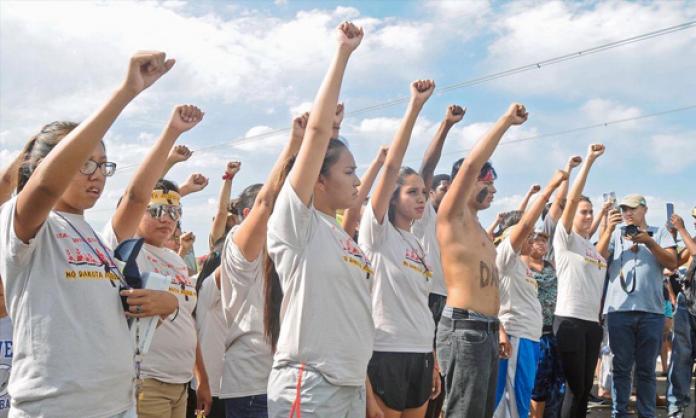A battle over the construction of a crude oil pipeline in North Dakota has become an explosive national issue. On one side stand Native Americans and their supporters. On the other are finance capitalists and the federal and North Dakota state governments.
The pipeline is scheduled to go underneath Oahe Lake, part of the Missouri River, near the Standing Rock Sioux reservation. The $3.8 billion project would carry 500,000 barrels of shale oil per day more than 1,800 km from North Dakota to a terminus in Illinois. Dakota Access is a joint venture of ETP and Sunoco Logistics. Enbridge, Inc., which has many pipelines in Canada and the US, and Marathon Oil have bought into the venture.
In addition, big multinational institutions are financing the project. These include Wells Fargo, BNP Paribas, Royal Bank of Scotland, Bank of Tokyo-Mitsubishi, ABN-AMRO Capital and Société Générale.
Against these powerful interests are ordinary workers, farmers and environmental activists spearheaded by indigenous peoples (Native Americans in the US and First Nations in Canada). The resistance took a major step forward when the Standing Rock Sioux Tribe set up an ongoing protest camp near the Missouri River, called Sacred Stone, while snow was still on the ground in April. Any future oil leak would threaten their drinking water, and the construction process would destroy sacred burial grounds.
The Sioux say that any leak would pollute the Missouri, which unites with the Mississippi, and affect people all the way to the Gulf of Mexico. They also point out that climate change, driven by the burning of fossil fuels such as oil, is a threat to people all around the world.
Sacred Stone started out small. Then other tribes in the US and Canada heard about it and took up the issue. Some 180 tribes have joined the Sioux in the fight. The encampment swelled to more than 1,000 in July, when the US Army Corps of Engineers approved the pipeline. People in the growing encampment put their bodies and horses on the line to block construction. Twenty-eight had been arrested by mid-August.
Among those coming to Sacred Stone was Dennis Banks, a leader of the American Indian Movement during the radicalisation of the 1960s and 1970s. In 1973, AIM was involved in an armed confrontation with the US government and seized the town of Wounded Knee, on the Pine Ridge Indian Reservation in South Dakota. Wounded Knee was the site of a massacre of Native Americans in 1890.
“What’s happening [at Standing Rock] is equally important [as Wounded Knee]”, Banks told Democracy Now!, a progressive news outlet. “We are part mountain. We are part ocean. We are part river. We are part flower and grass and tree. All of this, we are part of all of it, so that when they threaten the environment, they’re threatening you. You have to be in that mind-set. That’s who you are. That’s who we are. And our culture, our heritage is what has made us warriors.”
David Archambault, chairperson of the Standing Rock Sioux, said, “All the things that have happened to tribal nations [across the US] have been unjust and unfair … all too often we share similar concerns, similar wrongdoings to us, so we are uniting, and we are standing up, and we’re saying, ‘No more!’”
There was a lull in construction while court cases were heard. On 2 September the Standing Rock Sioux filed a lawsuit to stop the destruction of their sacred burial ground. The next day, not waiting for the court, the company began to bulldoze the site.
When protesters swarmed in to block the assault, private security guards attacked them with dogs and pepper spray. Democracy Now! took footage of the attack and melee, including of a dog with a mouth bloody from biting a protester. Also present was Green Party presidential candidate Jill Stein and her running mate Ajamu Baraka. Stein was shown spray painting “I approve this message” on the blade of a bulldozer.
A few days later, the North Dakota attorney-general issued arrest warrants for Democracy Now! host Amy Goodman, and Stein and Baraka, for “criminal trespass”. On 9 September, a racist judge ruled against the Sioux lawsuit. Embarrassed in the face of what has become a national scandal, the White House immediately ordered a temporary halt to construction under the river, and then a federal court extended the halt.
The temporary ruling is to allow the Army Corps of Engineers to reconsider its approval of the pipeline going under the Missouri River, and for a reconsideration of the destruction of the sacred burial ground. Tribes are supposed to have input.
Confrontations have continued at other construction sites in North Dakota, with protesters locking arms and chaining themselves to heavy equipment.
The pipeline is also facing resistance in Iowa, from ranchers, farmers and homeowners. A lawsuit is being brought by 15 farmers to stop Dakota Access from seizing their land under “eminent domain”. Eminent domain originally allowed federal, state and local governments to take over land for public projects like roads and highways. In 2005, the robed reactionaries of the Supreme Court ruled that it could be used by private companies to seize land.
On 13 September, rallies in support of the struggle in North Dakota were held in dozens of cities across the country. David Archambault has now taken the case to the United Nations Human Rights Council in Geneva. “While we have gone to court in the United States, our courts have failed to protect our sovereign rights, our sacred places and our water”, he said.
“We call upon the Human Rights Council and all members, all member states, to condemn the destruction of our sacred places and to support our nation’s efforts to ensure our sovereign rights are respected. We ask you to call upon all parties to stop the construction of the Dakota Access pipeline and to protect the environment, our nation’s future, our culture and our way of life.”










